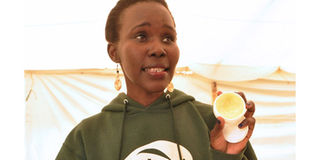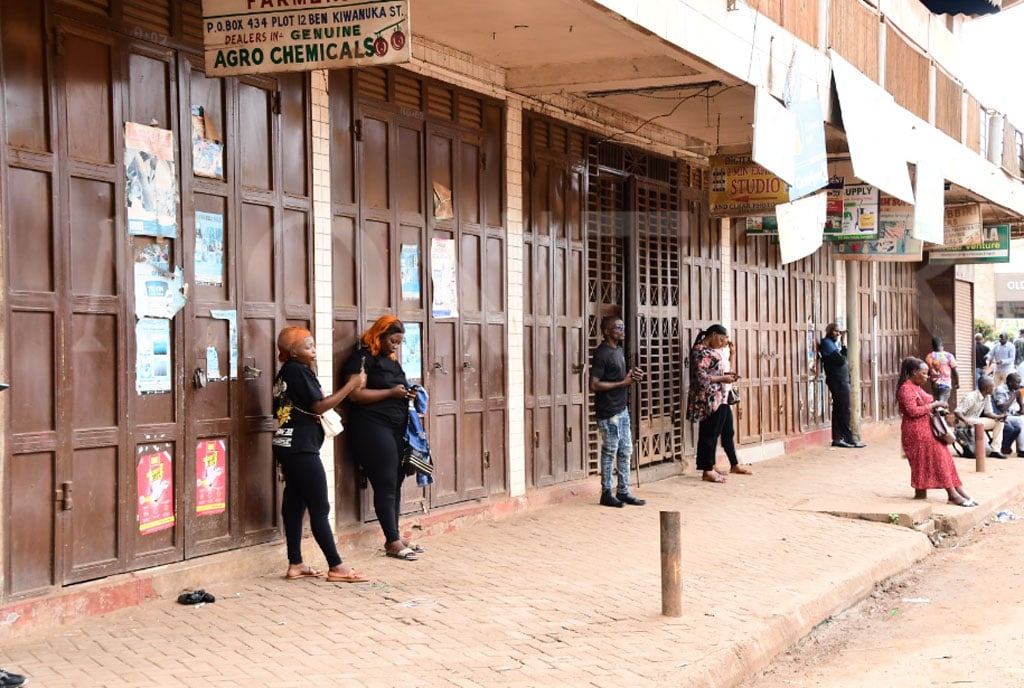Earn millions from shea nut products

Ms Sandra Letio, founder and managing director Pelere Group exhibits Shea butter products, explains how she makes these products in Kampala. PHOTO BY ERONIE KAMUKAMA
What you need to know:
Seven women groups have been processing butter, lip balm, aftershave, and hair spray among other products, from shea nuts, Eronie Kamukama.
At City Square gardens in Kampala town, music soars through the air as people from different walks of life go about their day. Suddenly, the volume lowers and through the microphone, is an invitation for the day’s city dwellers to shop for food and skin care products.
Shea nut products have been processed and brought from as far as Otuke and Agago districts to Kampala for exhibition.
Uganda Export Promotions Board (UEPB) marketing executive Sam Karuhanga says the seven women groups showcasing their products are using it to encourage the purchase of shea butter products and create awareness on certification to ease access to local supermarket shelves locally and internationally.
The Shea nut tree found in Acholi, Lango, West Nile and Karamoja, for many years remained a part of traditional dishes and was also cut down to make charcoal. For one to trade in shea butter products, they had to import.
Increasingly, Ugandans have started seeing the shea tree as more than a source of baby oil and food.
“There is increased recognition of the shea tree as a source of income because many products have been developed such as shea butter cosmetics, lotion, bar soap, hair food and oil, lip balm, lip shine,” Mr Karuhanga says.
Ms Sandra Letio, founder Pelere Group, has been adding value to the shea nut for seven years now and claims to control the value chain right from the farmer.
“We work with 50 farmer groups,” she says. “Business is growing. We are getting there in terms of research.”
She has spent the seven years processing butter, lip balm, aftershave, and hair spray among other products, from shea nuts. Pelere Group produces between one and five tonnes of shea butter a month and earns more than Shs10m in sales per month.
“Production is expensive because you are buying from a farmer at a premium price, a dollar per kilogramme but also the process of making the butter is costly and you can only decrease the costs if you do massive production,” Ms Letio says.
Ms Grace Akot, coordinator Agago District Farmers Association, says after almost two years of producing shea butter, soap and lotion, it is still difficult to determine the real cost of production.
“If you counted picking it, drying it and pressing the nuts in the machine, it is a difficult thing to cost. It needs finances to get a particular person to do it for you and we don’t have that funding. So we use market prices,” Ms Akot says.
She says businesses are thriving on repeated sales and referrals from existing customers. “When we come for exhibitions, we can make sales but not many. I have not sold up to Shs1m. Sales at home do not go beyond Shs200,000 because it is our old customers who keep buying most,” she says.
Benefits of shea tree
Despite this, the 600 farmers are taking their production further. Research has revealed to them that the shea tree is medicinal.
“It can be used as a mosquito repellant and its back to treat fresh wounds. We are going to reach that point where we can make repellants,” she says.
At Shea House, Mr Patrick Ogwang sees growing interest in the nut right from the grassroots to the processors.
“Competition is growing because of its massive application,” Mr Ogwang says.
Shea House started processing shea butter products in 2015 including massage oils, lip balm, soap, hair food and body butter. Mr Ogwang, a business development manager, says the company earns between Shs25m to Shs30m in sales every month. Exports to Canada, Uruguay, and Germany account for half of the sales.
However, it takes a lot more for these businesses to make the most out of the shea nut. There are issues to tackle.
“It is difficult to store because it is an oil seed so problematic to keep for long. Post-harvest handling is wanting because the farmer doesn’t know standards. If you find the nuts have moulds, whatever butter you get out cannot last,” Ms Akot says.
Quality of some products distorts market perceptions. “We are all classified as having poor quality because of a few players. Some duplicate products without improving them,” Mr Ogwang says.
Mr Letio, on the other hand, says the country’s weak policies hinder operations.
“Selling without certification takes longer for you to convince someone to buy the product. No one had information on shea. So we got certified by the American Shea Butter Institute. Besides certification, we do research, training ourselves and all these eat into our profits,” she says.
But also, not so many people know the importance of the shea tree and are cutting down the trees.
Sustainability concern
But Districts are yet to map their areas to establish the total acreage of the shea trees in the country. Natural resources office in Agago District, however, says, 80 per cent of the trees are Shea trees.
In Otuke, officials say there are more than 20 trees in every household. Government’s focus is now to ensure farmers protect the tree so that businesses are not temporary.
Mr Karuhanga says the shea nut tree can be a major income source for the people in the growing areas and the country at large because there are shea nuts that are not collected.
“We have seen local sales increasing by 20 per cent ever since we started the project (Kidepo Critical Landscape project,” he says.
He explains, “You need a quality product to export. Then register with UEPB, URA, there are no charges for that. If you don’t have the market, we give you leads. We can advise you on interpreting contracts but we don’t get involved in negotiations.”
Export markets include Kenya, Rwanda, United States of America, Canada, Germany, France, Japan, South Korea, Middle East and United Kingdom.
Peak time
Uganda National Bureau of Standards has developed quality guidelines for shea products. Players say the benefits of investing their money are about to get even clearer.
“Now, we shall have a quality mark which increases confidence in the market so we expect more sales. What we are left with is constructing a factory, getting better equipment to meet capacity,” Ms Letio says as she hopes to cash in on export markets in India, Germany, South Africa and Netherlands.




